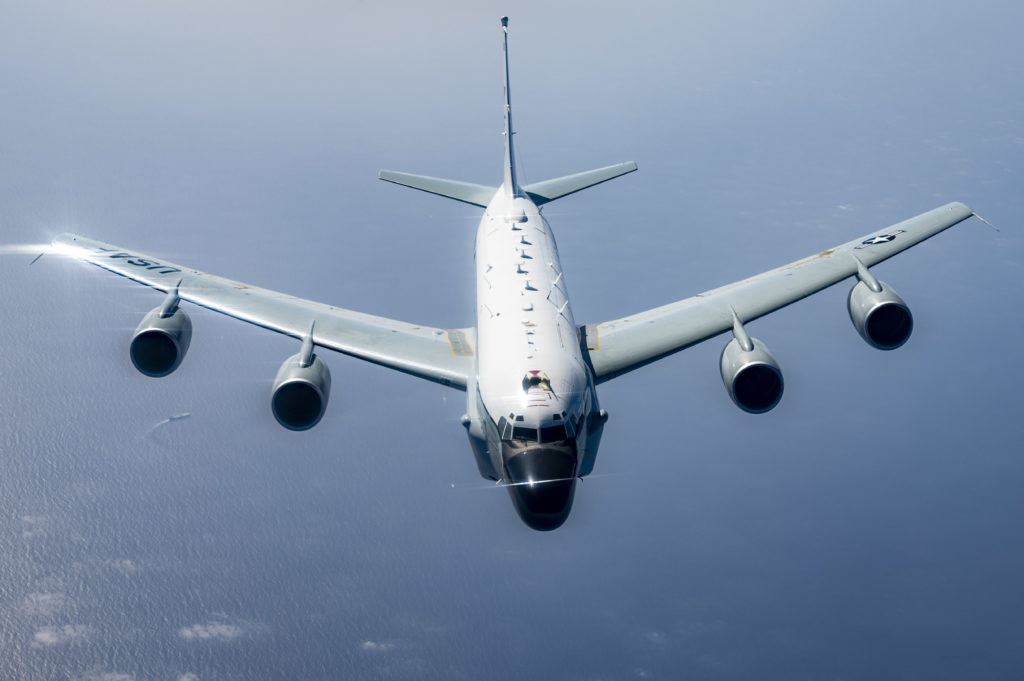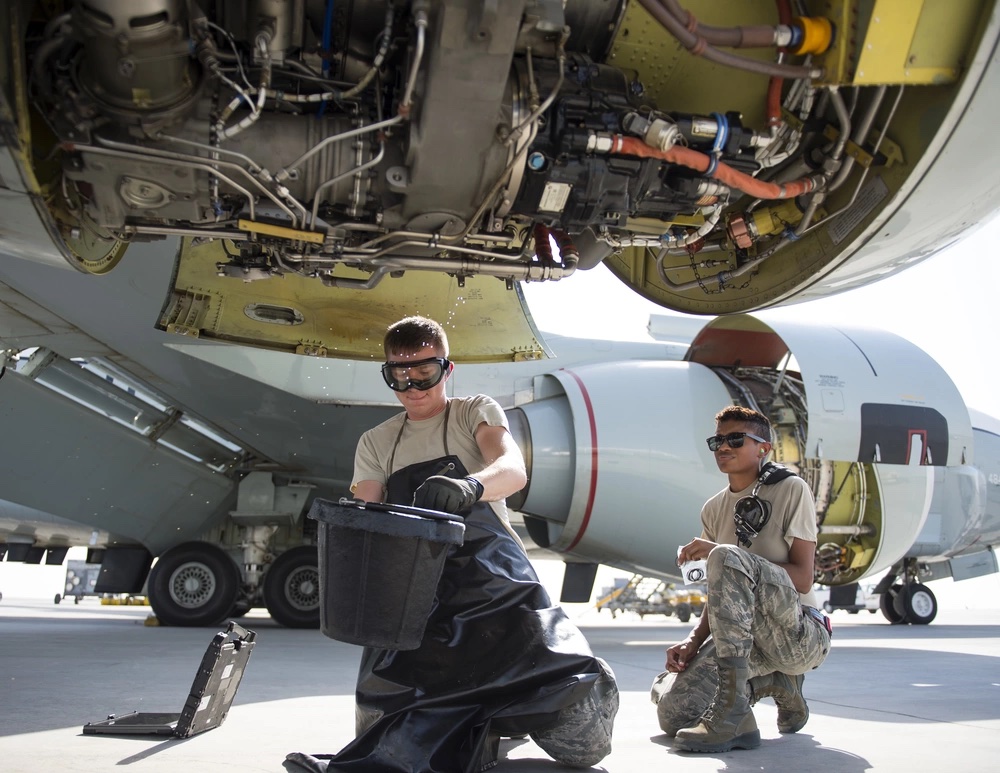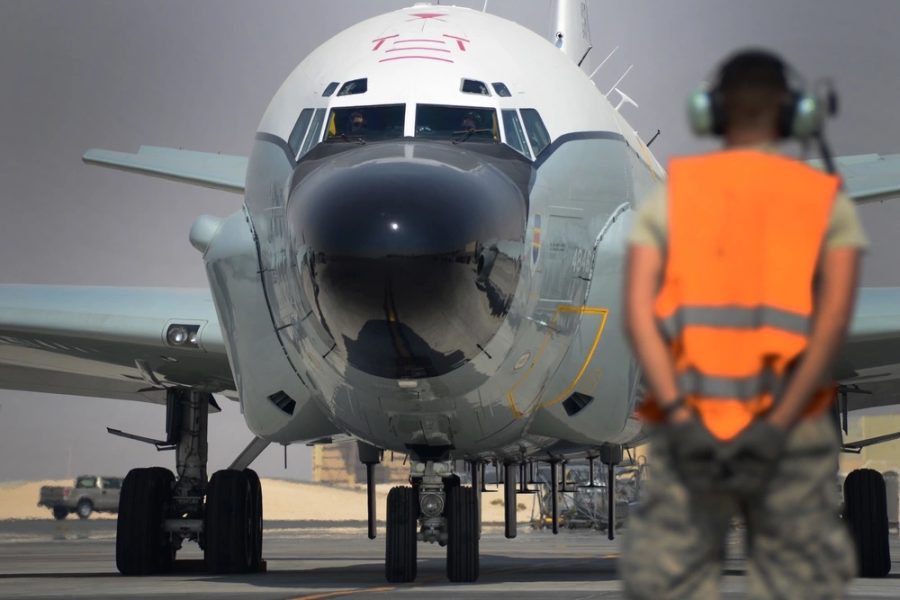OFFUTT AIR FORCE BASE, Neb.—They were manufactured in the early 1960s and are deployed almost constantly around the world. But the Air Force’s fleet of RC-135 intelligence and reconnaissance aircraft enjoy some of the highest mission capable rates in U.S. military aviation.
“We’re flying this fleet very hard, we’re currently at about 108 percent above where we think we should be,” in terms of operational load, Col. Kyle Clement, commander of Offutt’s 55th Maintenance Group, told Air & Space Forces Magazine.
“Not only are the metrics looking good, but the jets are cooperating; we’re able to fly more than we think,” he added.
With 28 total airframes total, the fleet has several variants—17 RC-135V/W Rivet Joints act as mobile listening posts, collecting real-time electronic and signals intelligence; three RC-135S Cobra Balls study ballistic missile activity; two RC-135U Combat Sent aircraft locate, identify, and analyze radar signals; three WC-135R/W Constant Phoenix jets collect samples of the atmosphere to detect nuclear weapons testing; and three TC-135Ws serve as training aircraft.
How the Air Force manages to keep them all flying at extremely high rates is a combination of extensive maintenance and modernization.
Every few years, each jet is sent to the depot at Greenville, Texas, known as ‘Big Safari’ for an extensive overhaul where they are almost completely disassembled, explained Joe Bucher, an airframe equipment specialist with the Air Force Engineering and Technical Services.
“They call it the dinosaur,” he said. “All you’ll see is the ribs, and the skin will be mostly off.”

The RC-135s are gutted to make way for updated systems equipped with faster software. The combination of hardware and software installed on the jet is called a baseline. The current baseline 13 is nearly all digital: the cockpits sport glass screens rather than old-fashioned gauges, and the streamlined backend system for intelligence collection has far more computing power than past baselines.
Jeremy Martin, an L3Harris mission systems technician, compared the difference between baseline 13 and 7, which he encountered when he first served as an Airman aboard the Rivet Joint in the early 2000s, to the advance in video game consoles over the same period of time.
“It’s literally going from Coleco or Atari to PS5,” he said. “The capabilities that we had at baseline 7, we couldn’t dream of where we’re at right now.”
Keeping up with the fast pace of change is a necessary part of staying ahead of competitors, Clement said.
“That’s why we do this. We have to be ahead of the innovation that China’s bringing to the table,” he said. “There is no second place here.”
The result is that the year of manufacture painted on each jet’s tail has little relation to the systems on the inside.
“Truly the only thing that’s really old on this plane is the number itself that’s on the tail, maybe the N-1 magnetic compass, and the pencil sharpener. That’s about it,” Martin said. “The rest of this stuff has all been updated, it’s a lot of cutting-edge stuff that’s on this plane.”
Fit to Fly
Even the best technology is useless without an airworthy jet, though, which is where the 55th Aircraft Maintenance Squadron comes in, spending hours fixing the control surfaces, engines, cables, lights, and other mechanical components that make RC-135s fly. Some of the jets used to serve as presidential transport, medical evacuation, or refueling platforms before joining the 55th Wing, giving each small differences and a distinct personality.
“Just last year, our brand-new WC-135s were operational KC-135s,” said Master Sgt. Josef Schueler. “They all have a life.”
Each aircraft has a complex array of subsystems that also require upkeep. For example, the advanced electronics aboard the Rivet Joints generate large amounts of heat, which is why they sport two air conditioning systems and a liquid cooling system.
“That’s a difference when you look at us versus Delta [Air Lines],” said Clement. “All they have is hydraulics, tires, the basics. We have to have all these other systems up and running.”

Rust can ground aircraft as easily as a mechanical failure, which is why Tech Sgt. Justin Boettger, the noncommissioned officer in charge of aircraft structural maintenance, spends much of his time fighting it off.
“The majority of our job here is painting and corrosion control,” he said. “With the age of these aircraft, corrosion issues do happen from time to time, and we make sure that they stop in their tracks.”
Besides rust, Boettger and his team also patch up aircraft after cracks, bird strikes, lightning strikes, or other bangs and scratches. But when a part breaks and the factory that makes it has been closed for decades, the fabrication section of the 55th Maintenance Squadron tries to make it on their own.
“Just about 10 times out of 10, we can make those parts,” said Tech Sgt. Isaac King, noncommissioned officer in charge of the fabrication section.
The shop uses various computer-guided machines to cut through steel, including one that shoots a stream of high-pressure water mixed with bits of garnet. When blueprints for the part are unavailable, the Airmen reverse-engineer it.
“Things break and wear over time,” said King. “It’s very unique to say ‘all I need is the raw material, and either a part to take measurements on, or a blueprint to draw it up with,’ and we’ve got the experience to be able to do it.”
80,000 Hours
The 55th Wing has had difficulties with maintenance in the past. A 2018 investigation by the Omaha World-Herald found hundreds of missions aborted or scrubbed due to pervasive mechanical problems. One particularly dangerous WC-135 had the nickname ‘Lucifer’s Chariot,’ though that exact subvariant of WC-135 has since been replaced with jets with larger motors and more available spare parts.
Today, however, the 55th’s RC-135 metrics are impressive: the jets average 1,007 flight hours a month, despite being contracted for 928. The average mission capable rate is 76 percent for fiscal year 2023, which is right on the Air Force standard. In March, one of the Rivet Joints, tail number 4841, even achieved black-letter status, which means an inspection found zero maintenance problems aboard the aging jet. Such an accomplishment is rare in the Air Force: Clement himself has encountered just two in his 29-year career. The metrics are all the more impressive considering the heavy demand on the fleet.
“We’re always all over the world,” Clement said. The jets “could be in the Middle East, they could be in Asia, they could be in Europe, and those are just the main operating locations.”
The entire fleet is due to receive a life-cycle extension to pull its service out to 80,000 flight hours, which should see the aircraft flying into 2050.
“It’s a very small fleet, so every aircraft makes a difference,” Clement said. “That’s why we spend so much investment in each aircraft, because each is a national asset.”


